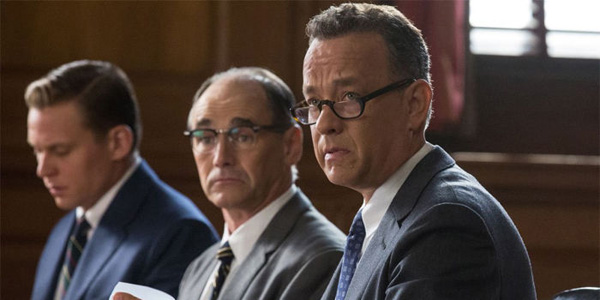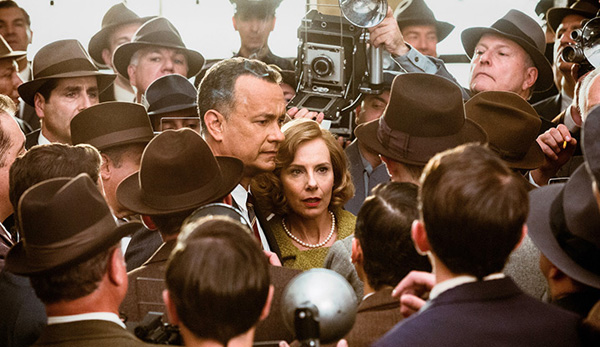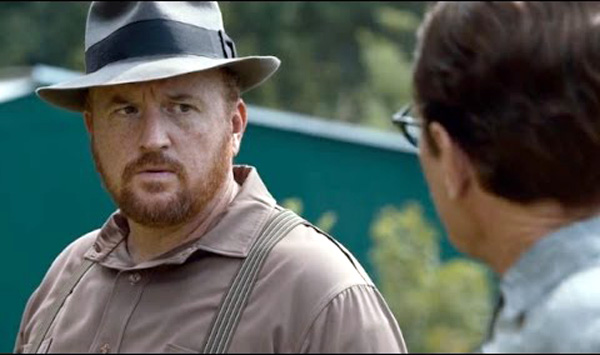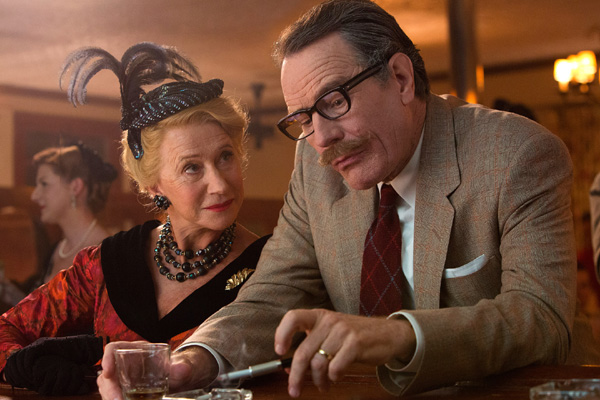|
For a time during the years after World War II, James B. Donovan and Dalton Trumbo—two very different men, with very different
professions and backgrounds—were among the most hated people in America. Both men could be considered collateral damage of the Cold War, but each triumphed over his
tribulations in his own way. Two new films--Steven Spielberg’s Bridge of Spies and Jay Roach’s Trumbo—demonstrate how they did so.
Featuring a screenplay by Matt Charman and Joel and Ethan Coen, Bridge of Spies begins with Donovan (Tom Hanks), a well-regarded Wall
Street tax attorney, being handed an assignment he never sought. Thomas Watters (Alan Alda), senior partner in Donovon’s firm, tells Donovan he has been selected by
the federal government to defend Rudolf Abel (Mark Rylance), a captured KGB agent. The assignment is mandatory and non-negotiable, Watters says.

Watters and the FBI expect Donovan to put up a respectable façade of criminal defense, and the trial to be merely a way
station on Abel’s path to the electric chair. They are unpleasantly surprised when Donovan insists Abel has the same
rights of due process as any defendant in a U.S. court, and furious when Donovan gets Abel off with thirty years in federal
prison. They aren’t the only ones who are furious: Donovan’s teenage daughter is sitting in their living room one evening when
shotgun blasts shatter the front window. The cops who answer Donovan’s call make it plain they wish they were investigating
not an assault with a deadly weapon, but a multiple homicide.
But Donovan says he is glad he saved Abel’s life, and for a very specific reason. Someday, he says, the Soviets will capture an
American agent, and America will need a bargaining chip.
That day comes when Francis Gary Powers (Aaron Stovall), a U.S. Air Force pilot, is shot down over the Soviet Union in a CIA spy
plane. CIA Director Allen Dulles (Peter McRobbie) empowers Donovan to go to Berlin to negotiate a swap—Powers for Abel.
But soon a complication arises: Frederic Pryor (Will Rogers), a young American graduate student in Berlin, is caught behind the
Berlin Wall on the very day it goes up, and the Stasi charges him with espionage.
Donovan demands the release of both Powers and Pryor in exchange for Abel, a position both the CIA and the Communists
find unacceptable. The CIA doesn’t give a damn about Pryor—only about Powers and the secrets he knows. The
Communists insist freeing both men in one deal is out of the question, because the KGB holds Powers and the Stasi holds
Pryor. The East Germans, whose sovereignty the U.S. does not acknowledge, are particularly insulted, and go out of their way to
humiliate and intimidate Donovan in any way possible.

Thanks to Spielberg, cinematographer Janusz Kaminski and production designer Adam Stockhausen, Bridge of Spies looks
exactly right, especially in its second half. The action moves from the New York of My Favorite Year to the Berlin of The Spy Who Came In from the Cold, and Spielberg makes sure we feel
the total shock of those frigid, rubble-filled streets. The cat-and-mouse tension portrayed in those streets approaches Le Carre
levels, though the hopelessness is dialed back considerably. This is, after all, a Steven Spielberg movie.
As with any Spielberg movie, the casting is impeccable, starting with Tom Hanks. This is the fourth starring role Hanks has
played for Spielberg, and—as with Saving Private Ryan—Hanks shows himself to be the heir of James Stewart in the portrayal of
all-American probity and courage. His James Donovan sometimes seems like Mr. Smith wandering into Tinker, Tailor, Soldier, Spy, and we are frightened for Donovan in the midst of
this cold-blooded lot. But, unlike them, we know better than to underestimate Donovan.
Rylance’s Abel, on the other hand, is right at home in this milieu,
except that he was unfortunate enough to get caught. As he also demonstrated in Wolf Hall, Rylance is one of the pre-eminent
experts in portraying men of equivocal and contradictory thoughts, in uneasy and perilous situations.
Other fine performances come from Alda, Amy Ryan as Donovan’s wife, and Sebastian Koch as an East German lawyer
who amuses himself by playing sadistic political games with Donovan. Koch’s role in Bridge of Spies makes a fascinating contrast with his role in The Lives of Others, playing a very
different kind of East German.
The victory achieved by Donovan over the little gray men was never in the cards for Dalton Trumbo, a committed far-left
liberal who belonged to the American Communist Party from 1943 to 1948. If Donovan was something of a pawn in the Cold
War, Trumbo was an out-and-out victim, going in the space of a year from being the highest-paid screenwriter in Hollywood to
being a convict and a pariah who had to resort to subterfuge to earn a living. He couldn’t beat his enemies politically; his triumph was to outlast them.
In the screenplay by John McNamara, Trumbo (Bryan Cranston) is a classic Hollywood eccentric, witty and brash, typing madly in
the bathtub with a cigarette holder between his teeth and a bottle of scotch at the ready. He enjoys the lavish lifestyle his
screenwriting fees afford him, which doesn’t sit well with some of his fellow lefties. “You preach revolution, but you live like a
rich guy!” grouses Trumbo’s friend Arlen Hird (Louis C.K.). Trumbo blithely replies that revolutionaries and rich guys have more in common than Arlen thinks.

However, Trumbo’s days as a rich man are numbered. Doom comes at him from two fronts: the House Un-American
Activities Committee and the Motion Picture Alliance for the Preservation of American Ideals. In an early scene in the film,
Trumbo has a tense confrontation with John Wayne (David James Elliott), the Alliance’s president. (Such a confrontation
probably never took place. “I never knew John Wayne—as friend or enema,” Trumbo told Dick Cavett in the early 1970s.)
Trumbo’s true enemy, however, is Hedda Hopper (Helen Mirren), the vindictive gossip columnist and cheerleader for the
Alliance. When Wayne suggests that those who have named names before the HUAC should be welcomed back into the Hollywood fold, Hopper coldly informs him that he can be
denounced too. When Trumbo goes to Washington as part of the Hollywood Ten, and categorically refuses to name names,
Hopper makes sure that Trumbo becomes the American face of the Red Menace.
Meanwhile, Trumbo is shipped off to federal prison in Kentucky, where the guards and even his fellow convicts treat him as the
lowest of the low. Cranston, Roach and McNamara make us feel every second of Trumbo’s humiliation. The humiliation doesn’t
end when he returns to his wife Cleo (Diane Lane) and their children; they are forced to move to a cheaper house, where their new next-door neighbor greets them by throwing dead
animals into their pool.
The rest of Trumbo tells of his struggle to make a living during the Blacklist, selling scripts under other writers’ names, or
under pseudonyms for Poverty Row producers such as Frank King (John Goodman). He writes the same way he always did, at
breakneck speed, in the bathtub; the only difference is that the scotch is a cheaper brand. Because he doesn’t dare show his face
at the studios, he enlists his wife and children as couriers. His peremptory demands on this front create a great deal of family tension.

Cranston is a marvel as Trumbo. Whatever sins he committed that caused him to be stranded in Godzilla, they have been fully
expiated, and he has been rewarded with a role that gives him as much chance to show off his talents as Walter White did. His
Trumbo is caustic, bullheaded, courageous, a born survivor who can face the Blacklist in his middle age just as he did the Depression in his youth.
The supporting cast, likewise, is extraordinarily vivid. The actors who play famous figures—Elliott as John Wayne, Michael
Stuhlbarg as Edward G. Robinson, Dean O’Gorman as Kirk Douglas, Christian Berkel as Otto Preminger—are at least
reasonably convincing, but it is Mirren’s Hopper that truly shines among them. Some critics have blasted Mirren’s
performance as arch and stiff, forgetting that the real Hopper was arch and stiff. Wearing her trademark hats like battle
helmets, Mirren’s Hopper exudes sadistic malice with every insincere smile.
Diane Lane, that most underrated of actresses, is warm and touching as Cleo, as is Elle Fanning as Trumbo and Cleo’s
daughter Niki. Louis C.K. brings real poignancy to his role as Arlen Hird, as resolute in his beliefs as Trumbo but far less able
to adapt. John Goodman has a whale of a time as Frank King, who is Trumbo’s match for brazen courage. Anyone who has seen the trailer for Trumbo has already seen Goodman’s best
scene, involving a flunky for the Motion Picture Alliance and a baseball bat.
Taken together, Bridge of Spies and Trumbo give us a convincing perspective on a troubled time in the history of
America—one that is uncomfortably like our own. In the face of a nebulous and terrifying menace, our nation’s elected officials
take a resolute stand against starving refugees and displaced orphans. Hedda Hopper would be proud.
|